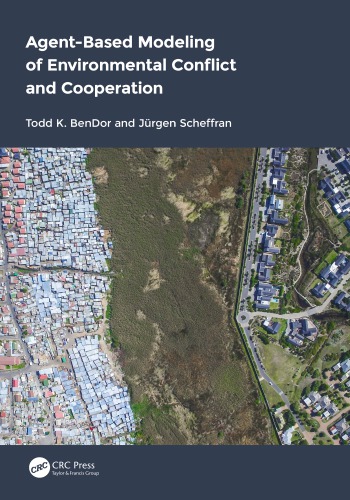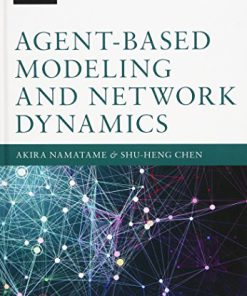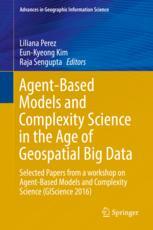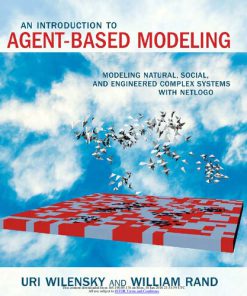Agent Based Modeling of Environmental Conflict and Cooperation 1st Edition by Todd Bendor, Jurgen Scheffran ISBN 1351106244 9781351106245
$50.00 Original price was: $50.00.$25.00Current price is: $25.00.
Agent Based Modeling of Environmental Conflict and Cooperation 1st Edition by Todd K. Bendor, Jurgen Scheffran – Ebook PDF Instant Download/Delivery: 1351106244, 978- 1351106245
Full download Agent Based Modeling of Environmental Conflict and Cooperation 1st Edition after payment

Product details:
ISBN 10: 1351106244
ISBN 13: 978-1351106245
Author: Todd K. Bendor, Jurgen Scheffran
Conflict is a major facet of many environmental challenges of our time. However, growing conflict complexity makes it more difficult to identify win-win strategies for sustainable conflict resolution. Innovative methods are needed to help predict, understand, and resolve conflicts in cooperative ways.
Agent-Based Modeling of Environmental Conflict and Cooperation examines computer modeling techniques as an important set of tools for assessing environmental and resource-based conflicts and, ultimately, for finding pathways to conflict resolution and cooperation. This book has two major goals. First, it argues that complexity science can be a unifying framework for professions engaged in conflict studies and resolution, including anthropology, law, management, peace studies, urban planning, and geography. Second, this book presents an innovative framework for approaching conflicts as complex adaptive systems by using many forms of environmental analysis, including system dynamics modeling, agent-based modeling, evolutionary game theory, viability theory, and network analysis. Known as VIABLE (Values and Investments from Agent-Based interaction and Learning in Environmental systems), this framework allows users to model advanced facets of conflicts―including institution building, coalition formation, adaptive learning, and the potential for future conflict―and conflict resolution based on the long-term viability of the actors’ strategies.
Written for scholars, students, practitioners, and policy makers alike, this book offers readers an extensive introduction to environmental conflict research and resolution techniques. As the result of decades of research, the text presents a strong argument for conflict modeling and reviews the most popular and advanced techniques, including system dynamics modeling, agent-based modeling, and participatory modeling methods. This indispensable guide uses NetLogo, a widely used and free modeling software package, to implement the VIABLE modeling approach in three case study applications around the world. Readers are invited to explore, adapt, modify, and expand these models to conflicts they hope to better understand and resolve.
Agent Based Modeling of Environmental Conflict and Cooperation 1st Table of contents:
Part I: Conflict and the Promise of Conflict Modeling
1. Environmental Conflicts in a Complex World
- Introduction to Environmental Conflicts: Definition and relevance of environmental conflicts.
- Conflict and Scarcity: How resource scarcity contributes to conflicts.
- Why Resolve Environmental Conflicts?: Importance of resolving conflicts for sustainability.
- Conflict Resolution Goals: Aiming for sustainability through conflict resolution.
- Linking Sustainability and Conflict Management: The connection between environmental sustainability and resolving conflicts.
- History of Conflict Resolution: Evolution of conflict resolution approaches across various disciplines:
- Urban Planning
- Economics
- Water Resources Management
- International Relations
- Techniques: Mutual gains, conflict frames, and joint fact-finding.
- Approaches: Consensus processes, agent-based analysis, and system resilience.
2. Why Model? How Can Modeling Help Resolve Conflict?
- Introduction to Modeling: The concept and importance of modeling in conflict resolution.
- Mental Models: Using mental models to understand conflict.
- Formalizing through Simulation: The role of mathematics and simulations in formalizing conflict models.
- Implications: How modeling contributes to understanding and resolving conflicts.
- Cautions and Process: The three-step modeling process.
3. The History and Types of Conflict Modeling
- Models of War and Arms Races: Early conflict models in historical contexts.
- Typology of Environmental Modeling: Different approaches to environmental conflict modeling.
- Game Theory and Dynamic Models: The application of game theory and dynamic simulations in conflicts.
- Simulating Strategy: How strategic decisions are modeled.
- Network Analysis and Geography: Understanding conflict dynamics using geography and networks.
4. Participatory Modeling and Conflict Resolution
- Participation and Decision Making: Importance of participatory approaches in conflict resolution.
- Social Learning: The role of learning and collaboration in participatory modeling.
- Challenges and Evidence: Lessons learned from participatory modeling interventions.
- Modeling Approaches: System dynamics, simulation, role-playing, and decision analysis.
Part II: Modeling Environmental Conflict
5. System Dynamics and Conflict Modeling
- System Dynamics (SD): Introduction to SD and its application in conflict modeling.
- Participatory SD Modeling: The unique aspects of participatory SD modeling.
- Challenges: Issues like conflict during the process and the limitations of SD in conflict resolution.
6. Agent-Based Modeling and Environmental Conflict
- Agent-Based Modeling (ABM): Key features of ABM and its use in conflict modeling.
- ABM Philosophy: How complexity science informs ABM.
- Applications: ABM’s role in simulating agent interactions, spatial complexity, and human behavior.
- Validation and Empirical Basis: Ensuring the accuracy of ABMs through empirical data.
- Participatory ABM: Combining role-playing games with ABM to model social dynamics.
7. Modeling Conflict and Cooperation as Agent Action and Interaction
- Agent Decision Making: How agents decide and interact in conflict situations.
- Viability Theory: Using viability theory to model stability in conflict and cooperation.
- Multi-Agent Models: Exploring complex agent interactions and equilibrium in conflict scenarios.
Part III: Applications of the VIABLE Model Framework
8. Fishery Conflict and Cooperation
- Nature of Fishery Conflicts: Economic and ecological aspects of fishery-related conflicts.
- Modeling Fishery Sustainability: Agent-based models to simulate fishery management.
- Conflict Scenarios: Different modeling scenarios for sustainable fishery practices.
9. Adaptive Dynamic Model of Emissions Trading
- Climate Change and Conflict: The role of emissions trading in mitigating climate conflict.
- Modeling Emissions Trading: Defining emission targets and testing viability through modeling.
- Case Scenarios: Allocating permits and assessing economic viability under different scenarios.
10. Modeling Bioenergy and Land Use Conflict
- Bioenergy and Environmental Impact: Understanding the conflict between bioenergy production and land use.
- Farmers’ Role: How farming decisions influence bioenergy conflicts.
- Scenario Simulations: Modeling the introduction of new biofuels and assessing policy impacts.
11. Future of Modeling Environmental Conflict and Cooperation
- Reflection on Progress: Evaluating the evolution of conflict modeling.
- Future Questions: How can modeling become a standard activity in conflict prevention and resolution?
- Cross-Pollination of Methods: The promise of combining different modeling techniques for improved conflict resolution.
People also search for Agent Based Modeling of Environmental Conflict and Cooperation 1st :
netlogo agent based modeling
anylogic agent based modeling
an introduction to agent based modeling
agent based modeling artificial intelligence
agent based modeling a guide for social psychologists
Tags:
Todd Bendor,Jurgen Scheffran,Agent,Based,Modeling,Environmental,Conflict,Cooperation 1st
You may also like…
Engineering - Computer Technology
Computers - Programming
Politics & Philosophy
Politics & Philosophy
Politics & Philosophy - Anthropology
Science (General)
Computers - Computer Science
Politics & Philosophy - Cultural












